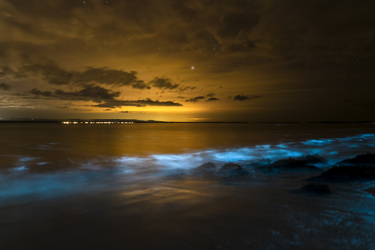A Lesson In Bioluminescence: Swimming With The Dinos

By Abby Proch, former editor

Forget swimming with the dolphins. Last month, I swam with the dinos.
Well, technically, dinoflagellates.
While these single-cell creatures can be vacation-ruiners — like when their blooms bring on the infamous, eye-stinging red tide along Gulf Coast beaches — this time, the Pyrodinium bahamense were downright delightful.
See, these dinoflagellates are bioluminescent, and when they get irked by something moving in the water around them, molecules of luciferin inside their bodies interact with oxygen and give off an incredible blue light. To see this marine wonder, I waited till dark and then ventured to Luminous Lagoon near Falmouth, Jamaica, where the waters of the Caribbean Sea and the Martha Brae River make a brackish brine that’s home to these glowing creatures. A tour boat took me and flock of wide-eyed wanderers just a quarter mile into the bay where we were invited to jump in. With every splash and stroke, the water awakened with an ethereal blue aura. It was just short of magic.
And while this phenomenon is awe-inspiring to us non-luminescent beings, to the dinos, it’s a defense mechanism meant to keep its predators at bay. Sounds counterintuitive given all the attention it draws, right? But researchers have found that dinoflagellates like these emit the light to prevent being eaten, because the light also exposes predators to their own predators. Other bioluminescent creatures such as fireflies use their glow for communicating with one another, attracting mates, and illuminating their surroundings to either see prey or attract their predators’ predators. Bioluminescence is certainly helpful to their makers for many reasons, but it’s also been known to help humans, too. According to some reports, World War II pilots in the South Pacific would rely on the bioluminescence of marine species just like these to help them identify their base ships during the night.
More recently, nature’s nightlights have inspired advances in medical imaging and research. Today, bioluminescent creatures’ luciferin-luciferase pairs are isolated, characterized, and then engineered to produce bioluminescent photons in tissue samples and live organisms, allowing researchers to conduct in vivo exploration of biological processes such as cell location and movement. Engineered luciferase based on that of bioluminescent deep-sea shrimp, called Nluc, has proven useful in the imaging of rodent models because of its high signal-to-noise ratio and emissions lasting longer than 30 minutes. It’s also stable at high temperatures and can endure a range of pH values. What’s more, it’s also been used in pathogen tracking, drug screening, and biosensing. Luciferases derived from bioluminescent beings also have the potential to replace optical fibers for light delivery. They overcome the downsides of optical fibers, which must be surgically implanted and uncontrollably radiate heat into surrounding tissue. Bioluminescent light may also serve as a replacement for UV light in the disbursal of cage molecule release, which can include cancer-fighting agents. And the applications continue to climb.
For most onboard that tour boat, grainy nighttime photos (note lack of original photo for this piece) and raving reviews will be the likely takeaways. And truth be told, I saw this excursion on the resort’s website and thought it would make for a fun time (and a fun editorial). But on top of being just plain cool, the bioluminescent creatures of Luminous Lagoon are just another reminder of how nature’s quirks (much like the story of the Mantis shrimp I recounted recently) can do more than delight and entertain.
If jetting off to Jamaica isn’t in your summer plans, consider exploring the larger world of bioluminescence with Sir David Attenborough’s full-length documentary, “Attenborough’s Life That Glows,” available on HBO Max and through channels on Amazon Prime.
